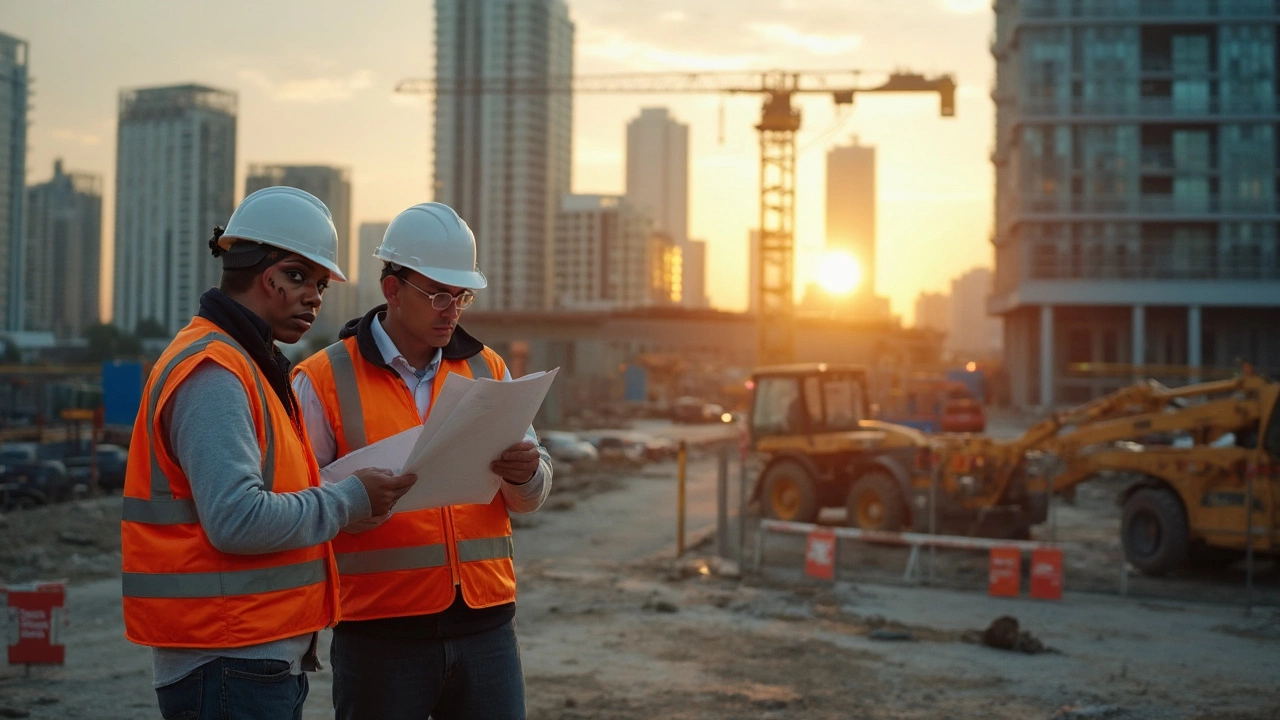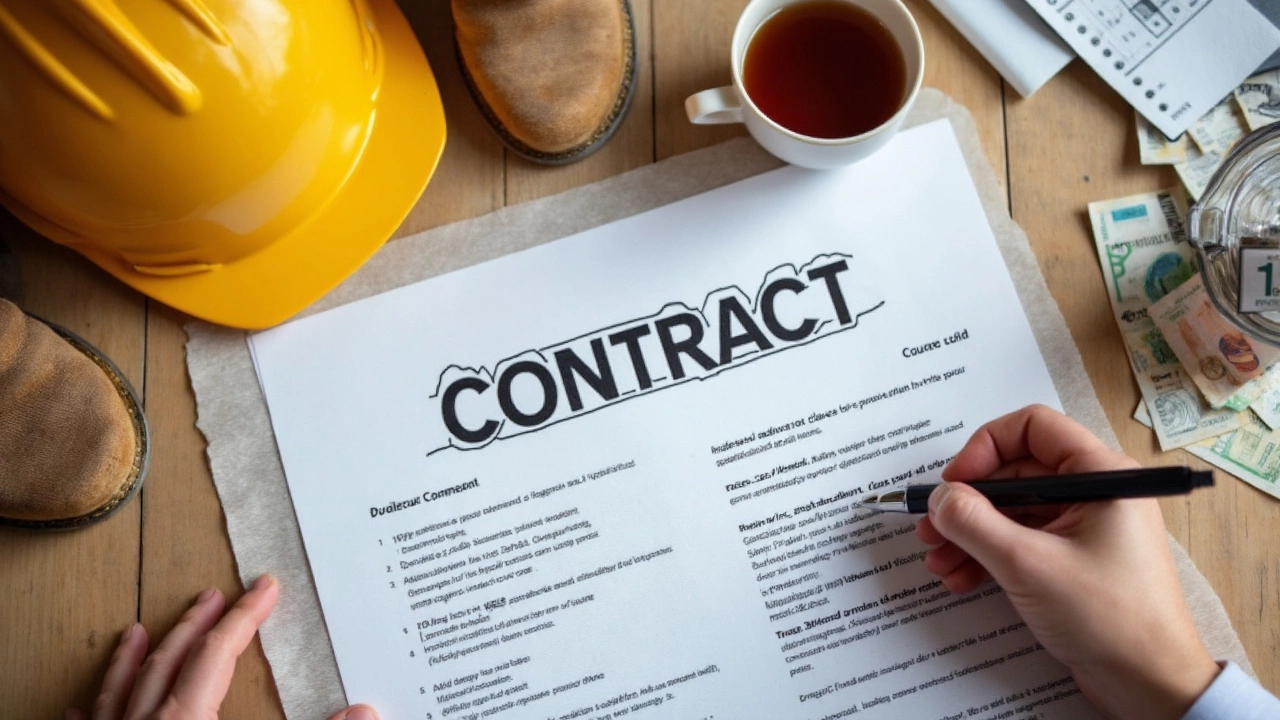Commercial Construction: What Gets Covered Every Time
 May, 9 2025
May, 9 2025
Ask anyone who’s done a commercial build: figuring out what’s actually covered is half the battle. You skim your contract and see terms flying around—core, shell, build-out—but what’s that really mean? Are floors, HVAC, landscaping, all tossed into the same basket? The details can make or break your budget, and nobody wants to discover a big-ticket item missed the coverage list just as work starts.
The trick is knowing exactly what gets included under ‘commercial’ in your project paperwork. It’s not just the walls and roof. There’s stuff like site prep, parking lots, sidewalks, lights, mechanical and electrical systems, and even tricky little things like fire sprinklers. Sometimes all these are bundled together, sometimes not. If you’re not asking the builder or your project manager detailed questions at the jump, you could end up paying for change orders later—think surprise bills for things you swore were already in the scope.
- Breaking Down Common Commercial Coverage
- What’s Usually Included in Construction Contracts
- Gray Areas: What Might Not Be Covered
- Tips to Double-Check Before You Sign
Breaking Down Common Commercial Coverage
If you’ve ever sat through a meeting with a builder or project manager, you’ve probably heard the phrase “That’s covered under commercial”—but what are they actually talking about? In most commercial construction projects, coverage usually means the nuts and bolts that make up the structure and keep the whole thing compliant with local code and ready for its intended use. It’s not a free-for-all, though. The basic inclusions are agreed on upfront for a reason, and not everything gets shoehorned into the contract.
Here’s the core stuff almost everyone expects their commercial project to cover:
- Core and Shell: This means the main skeleton—foundation, walls, floors, roof, and usually the exterior windows and doors.
- Building Systems: Think electrical wiring, plumbing, HVAC, and fire protection like sprinkler systems.
- Site Work: This includes clearing the lot, putting in utilities, paving parking areas, sidewalks, and sometimes basic landscaping.
- Life-Safety Features: Emergency exits, alarms, smoke detectors—basically, what’s needed to pass an inspection.
- Accessibility: ADA-compliant ramps, entrances, and restrooms.
According to the Construction Specifications Institute (CSI), these basics make up about 70-80% of the initial commercial contract value. It’s easy to see why everyone wants clarity, since change orders can add another 10-20% to final costs if something gets missed at the start.
“Everything looks easy on paper, but in commercial construction, details are everything. Get specifics in writing, or be prepared for surprises.” — National Association of Commercial Builders
A lot of owners get tripped up because they assume out-of-sight systems like underground drainage, or specialty items like exterior signage, are just baked in. They aren’t—unless it’s spelled out, don’t count on it. Take a look at the average breakdown of typical costs below, which can help gauge what’s prioritized in most commercial contracts:
| Category | Average % of Total Cost |
|---|---|
| Core & Shell | 40% |
| Building Systems (Electrical, HVAC, Plumbing, Fire Protection) | 30% |
| Site Work | 15% |
| Life-Safety/Accessibility | 10% |
| Contingency/Miscellaneous | 5% |
Watch for exclusions or vague items in your paperwork. If you want things like custom lighting, extra interiors, upgraded finishes, or security systems, you’ll need to bring that up early. Commercial coverage is generous—but only in the sense that what you negotiate at the start is what you get in the end.
What’s Usually Included in Construction Contracts
If you crack open a standard commercial construction contract, you’ll spot a few things almost every time. The main building part—meaning the core structure, walls, roof, and foundation—is right there. Most contracts also call out things like insulation, windows, and finished exterior surfaces. Anything that keeps the building weather-tight usually lands on the must-have list.
Mechanical, electrical, and plumbing (MEP) systems show up in almost every contract. This covers heating and cooling systems, ventilation, electrical wiring, outlets, lighting, fire alarms, water pipes, and sewer lines. If you spot these in the paperwork, you’re already ahead, since MEP mistakes can cost big bucks if you have to fix or add them later.
Site work is another piece you’ll often see. This means grading the land, drainage work, basic landscaping, and prepping the ground for the build. Some contracts also roll in parking lots, walkways, and exterior lighting. Need a loading dock or dumpster pad? Double check, but these are usually discussed early with your builder.
- Core structure (shell, walls, roof, foundation)
- Windows, doors, and exterior finishes
- HVAC, electrical systems, and plumbing
- Fire protection and safety systems
- Basic site prep and grading
- Some exterior work like walkways or parking areas
It’s rare for a contract to spell out every single item in plain language, so always ask for a breakdown if something’s unclear. If you see a word like “turnkey,” that means the builder’s handling everything needed to deliver a ready-to-use building—no weird gaps between what you expect and what gets built. If you hear “core and shell,” expect the basics to be covered but nothing fancy inside.
For anyone focused on commercial construction, reading what’s covered in the contract is key. If there’s ever a list of exclusions or special requirements, make sure to ask questions. Surprises in commercial builds usually mean spending more than you planned.

Gray Areas: What Might Not Be Covered
This is where a lot of folks get tripped up. Not everything falls under typical commercial construction coverage. Sometimes, something as simple as painting or window blinds gets left out, and everyone assumes the other side is handling it. Before you sign your name on that dotted line, it pays to know what’s probably not part of the deal—even if it feels obvious.
The most common gray areas are:
- Site furnishings like benches, trash cans, or planters
- Landscaping and irrigation beyond a basic seeding
- Furniture, fixtures, and signage—unless you specifically add them in
- Extra safety features like security systems (think cameras, alarms)
- IT, telecom, and audio-visual cables and gear
- Custom finishes and specialty lighting
- Permit fees and impact fees—these often sit outside standard construction budgets
If you’re curious what folks most often get surprised by, check out this quick table of commonly missed items by percentage of clients (according to a 2023 U.S. construction survey):
| Missed Item | % of Clients Surprised |
|---|---|
| Signage | 49% |
| Security Systems | 41% |
| Landscaping | 37% |
| Furniture & Fixtures | 35% |
| Custom Lighting | 28% |
Bottom line: Never assume. Contractors work off the written contract, not what’s been discussed casually over coffee. The clearer you get on scope now, the fewer headaches you’ll have down the line.
Tips to Double-Check Before You Sign
This is the real moment of truth—everything looks good, but hold up. Don’t just skim that contract or proposal. Here’s where folks trip up and end up on the hook for costs nobody mentioned upfront. Before making anything official, you need a game plan. Grab a highlighter and use these tips to keep surprises off the table.
- Commercial construction contracts often split work into phases. Read each phase—site work, core/shell, fit-out—line by line. If you see "by owner" or "excluded" anywhere, ask what that means in dollar terms.
- If the contract mentions "allowances," double-check what's actually allowed. Is that flooring price legit, or will you be hit with an upcharge the minute you pick the tiles you like?
- Look out for phrases like “as required by code.” It sounds official but can mean a bunch of extras if your city tightens regulations mid-project. Ask the builder how they’ll handle changes in permitting or building code updates.
- Don’t assume things like landscaping, signage, or furniture are in there just because they appear in a rendering. If it’s not spelled out, it’s probably not covered.
- Request a scope checklist. The best builders have a tidy table showing exactly what’s covered—structural, mechanical, electrical, exterior, finishes, landscaping, and so on.
If you like data, here’s a quick look at what’s most often missed in initial commercial construction coverage, according to the Construction Industry Institute’s recent survey:
| Item Usually Missed | % of Projects Affected |
|---|---|
| Landscaping | 64% |
| Site Utility Upgrades | 57% |
| Signage | 42% |
| IT/Data Systems | 35% |
| Security Systems | 31% |
If you’re still foggy after reading the contract, don’t be shy. Get your builder on the phone and ask straight-up, “If I walk the finished building, is anything missing I might expect?” If the answer isn’t clear, keep pushing. My wife Natalie once caught a missing elevator cab finish in a contract—everyone missed it. Saved us a five-figure headache later. Trust me, it pays to double-check now so you don’t get bit later.
